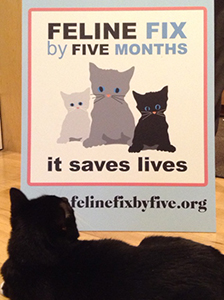Fix BY Five
Saves Felines
By Crystal C. Long
We are in the middle of a pet-related crisis! According to the ASPCA, approximately 7.6 million companion animals go into animal shelters each year in the United States. Out of this number, approximately 3.3 million are dogs, and 3.4 million are cats. But sadly, there might be more to this story…since there is no central data reporting system for animal rescues and organizations in the Unites States (and not every state requires shelters to report their numbers), all of these statistics are, well, just a guess. However, there is one thing we do know for sure: the overpopulation of cats far exceeds the overpopulation for dogs.

The uphill battle with cat-overpopulation falls into three main categories: people jump into being a pet-parent without first considering all the responsibilities therefore surrendering them to shelters when it becomes “too much work”; people shop rather than adopt; and lastly, failing to get their cat spayed, in time or not at all. After all, cats can have an average of five kittens per litter – and this number can multiply with each offspring…now that is a lot of kittens! And the harsh reality is that, the rate of a cats being adopted is much less than dogs. In fact, only 37% of cats in shelters are adopted and less than 5% of cats are returned to their humans.
But the problem might not be entirely our fault: conventional wisdom dictates that cats should be spayed or neutered at six months of age or older. But Director of Maine-based animal advocate organization, Marian’s Dream, Esther Mechler, disagrees. In fact, she advises that cats are best spayed/neutered by five months. This life-saving message is what her Fix by Five campaign is about. If we fix our cats by five months, not only will we get ahead of unplanned litters (and subsequently over-population), as cats can already be pregnant by six months, there are also numerous advantages attached, “if cats are fixed by five months (between two and five months) they will most likely not spray and mark and roam. It is those behaviors that often costs male cats their homes. Female cats are over 90% less likely to develop mammary gland cancer if they are fixed by five months.” Mechler stated. She goes on by saying, “Both of these are hormone-driven, and by spaying or neutering early in life-before the hormones kick in-we help keep cats in their homes and with the expectation of a happier, healthier life.”
It is to no surprise that Mechler is also a huge cat-lover, as she tells Pet Lifestyles Magazine about her infinite love for cats and how it all started, “When I was 7 or 8 years old I lobbied long and hard for a cocker spaniel but my parents never caved! Instead we somehow adopted a little black and white kitten. He stole our hearts for sure, and ever since I have had cats. Why? Because they’re so independent, so complex, so graceful, such individuals and they have so much to teach us.” Her love for felines is what ultimately inspired her to found the Fix by Five campaign, the core program of Marian’s Dream, a nonprofit that aims to end dog and cat overpopulation.
With a mission to reduce cat overpopulation by lowering the standard age of spaying/neutering for cats down to five months or earlier, Mechler’s Fix by Five campaign recently gained the approval of the American Veterinary Medical Association (AVMA), a collection of more than 93,000 veterinarians across different sectors, and is thought of as the leading voice of the profession.

The fact is, currently, three out of four people either have no knowledge of when to spay/neuter their cats or thought it was six months or older. And to this, Mechler strongly suggested to spread the word “The Fix by Five campaign now has vet support but now we need to raise public awareness,” she states “there are a lot of problems out there, and solutions are often costly and complicated. We are so pleased to have found a solution for several problems that plague felines -- can we make “cat parents” aware enough to be proactive with their kitties?” She sums it up to three simple points:
1. Medical: kittens spayed prior to first heat have a 91% lower risk of developing mammary gland cancer which takes the lives of an estimated 75,000 cats each year.
2. Behavioral: the hormones that develop if male cats are left unaltered lead to territorial fights, territorial spraying, and marking and roaming. Over 80% of cats relinquished to shelters or abandoned are unspayed/unneutered.
3. Community: over half the litters born are “oops litters,” who end up in shelters or on the streets. These unplanned, unwanted litters would not be born if cats did not go into heat.










